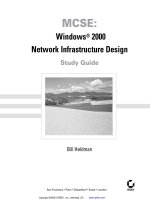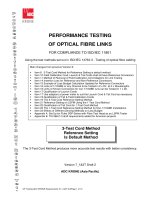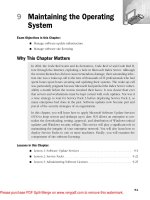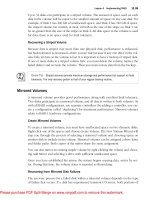Tài liệu MCSE Training Guide: Networking Essentials, ppt
Bạn đang xem bản rút gọn của tài liệu. Xem và tải ngay bản đầy đủ của tài liệu tại đây (5.09 MB, 660 trang )
Second Edition
Networking
Essentials
MCSE
TRAINING GUIDE
Exam: 70-058
Glenn Berg
01.919-x FM 8/28/98 10:08 AM Page i
I
S
TANDARDS AND
T
ERMINOLOGY
1 Networking Terms and Concepts
2 Networking Standards
PART
04.919-x Part1 8/28/98 10:59 AM Page 1
O
BJECTIVES
1
CHAPTER
Networking Terms and
Concepts
Chapter 1 targets the following objectives in the
Standards and Terminology section of the Networking
Essentials exam:
Compare a client/server network with a peer-to-
peer network.
. This objective makes sure you are familiar with the
two main network classification models.
Define common networking terms for LANs and
WANs.
. The purpose of this objective is to make sure peo-
ple working in the networking field understand the
difference between a local area network (LAN) and
a wide area network (WAN). These terms are the
main topics of discussion throughout this chapter.
Compare a file and print server with an applica-
tion server.
. This objective makes sure you are aware of the dif-
ferent types of servers in the field of networking.
05.919-x CH01.i 8/28/98 11:26 AM Page 3
O
UTLINE
Networking Concepts and Components 7
Models of Network Computing 9
Centralized Computing 9
Distributed Computing 11
Collaborative Computing 12
Network Models: Comparing
Client/Server and Peer-to-Peer
Networking Configurations 13
Client/Server Based Networking 13
Peer-to-Peer Networking 15
Local and Wide Area Networks 16
Local Area Networks (LANs) 16
Wide Area Networks (WANs) 16
Intranets and Internets 17
Network Services 18
Basic Connectivity Services 18
Redirector Service 19
Server Service 19
File Services 20
File Transfer Services 23
Data Migration 24
File Archiving 25
File-Update Synchronization 25
Printing Services 26
Application Services 26
Database Services 28
Messaging/Communication Services 30
Email 31
Voice Mail 31
Fax Services 31
Groupware 31
Directory Services 32
Security Services 33
Chapter Summary 36
05.919-x CH01.i 8/28/98 11:26 AM Page 4
S
TUDY
S
TRATEGIES
.
You need to be very familiar with the terminolo-
gy used throughout this chapter. This terminolo-
gy serves as a basis for the rest of the book
and for the exam.
.
Many different services are explained in this
book. Be prepared to understand the key
differences between a file and print server
and an application server, as well as the differ-
ences between client/server and peer-to-peer
networks. Remember that a file and print server
or an application server can be part of either a
client/server or peer-to-peer network.
.
Keep in mind that this chapter presents the
big picture—a 50,000-foot overview of
networking—while at the same time introducing
basic terminology and definitions that need to
be memorized.
05.919-x CH01.i 8/28/98 11:26 AM Page 5
6
Chapter 1 NETWORKING TERMS AND CONCEPTS
I
NTRODUCTION
As one of the required exams in the Microsoft MCSE certification
program, the exam for Networking Essentials challenges your knowl-
edge of computer networking components, theory, and implementa-
tion. This chapter is generic in the sense that it is not specific to any
one software or hardware vendor; instead, it introduces you to some
of the basic and rudimentary terms and concepts used when dis-
cussing networking. Real-world examples are provided whenever
possible. Study this chapter carefully; you will use these terms and
concepts throughout the rest of this book and in the real world, no
matter which networking model or system is being discussed.
Although most of this chapter’s examples are given in terms of
Microsoft solutions, all other successful networking models must
accomplish these same tasks.
This chapter begins with a definition of networking. It then moves
on to cover three different computing models used by various sys-
tems throughout the world. The discussion next turns to the two
main types of network models and then covers how networks are
classified based on various factors. The chapter goes on to describe
the various services that a network can offer.
In general, this chapter helps the reader understand some of the
broad classifications into which networks can fall. An appropriate
analogy might be motor vehicle classification—you should think in
terms of car, truck, or bus instead of a detailed description such as a
1969 Ford Mustang or a 1998 Honda Accord.
The integration of network services within personal desktop operat-
ing systems and the public emergence of the worldwide network,
also known as the Internet, have generated incredible momentum in
the movement to get connected. Networks have become the primary
means of disseminating information in most modern offices and
even in some homes.
05.919-x CH01.i 8/28/98 11:26 AM Page 6
Chapter 1 NETWORKING TERMS AND CONCEPTS
7
N
ETWORKING
C
ONCEPTS AND
C
OMPONENTS
Networking is the concept of sharing resources and services. A net-
work of computers is a group of interconnected systems sharing
resources and interacting using a shared communications link (see
Figure 1.1). A network, therefore, is a set of interconnected systems
with something to share. The shared resource can be data, a printer,
a fax modem, or a service such as a database or an email system. The
individual systems must be connected through a pathway (called the
transmission medium) that is used to transmit the resource or service
between the computers. All systems on the pathway must follow a
set of common communication rules for data to arrive at its intend-
ed destination and for the sending and receiving systems to under-
stand each other. The rules governing computer communication are
called protocols.
In summary, all networks must have the following:
á
A resource to share (resource)
á
A pathway to transfer data (transmission medium)
á
A set of rules governing how to communicate (protocols)
Hi, AHi, B
BA
FIGURE 1.1
In its simplest form, a computer network is two
or more computers sharing information across
a common transmission medium.
05.919-x CH01.i 8/28/98 11:26 AM Page 7
8
Chapter 1 NETWORKING TERMS AND CONCEPTS
Having a transmission pathway does not always guarantee communi-
cation. When two entities communicate, they do not merely
exchange information; rather, they must understand the information
they receive from each other. The goal of computer networking,
therefore, is not simply to exchange data but to understand and use
data received from other entities on the network.
An analogy is people speaking (see Figure 1.2). Just because two peo-
ple can speak, it does not mean they automatically can understand
each other. These two people might speak different languages or
interpret words differently. One person might use sign language,
while the other uses spoken language. As in human communication,
even though you have two entities who “speak,” there is no guaran-
tee they will be able to understand each other. Just because two com-
puters are sharing resources, it does not necessarily mean they can
communicate.
Because computers can be used in different ways and can be located
at different distances from each other, enabling computers to com-
municate often can be a daunting task that draws on a wide variety
of technologies.
Student
(client)
Air
(transmission
medium)
Instructor
(server)
FIGURE 1.2
Human communication is like a network.
05.919-x CH01.i 8/28/98 11:26 AM Page 8
Chapter 1 NETWORKING TERMS AND CONCEPTS
9
The two main reasons for using computer networking are to provide
services and to reduce equipment costs. Networks enable computers
to share their resources by offering services to other computers and
users on a network. The following are specific reasons for network-
ing PCs:
á
Sharing files
á
Sharing printers and other devices
á
Enabling centralized administration and security of the
resources within the system
á
Supporting network applications such as electronic mail and
database services
You will learn more about these important network functions later
in this chapter.
M
ODELS OF
N
ETWORK
C
OMPUTING
After you have the necessary prerequisites for network communi-
cation, a structure must be put in place that organizes how commu-
nication and sharing occurs. Three methods of organization, or
models, generally are recognized. The following are the three models
for network computing:
á
Centralized computing
á
Distributed computing
á
Collaborative or cooperative computing
These three models are the basis for the various types of computer
networks you learn about in this book. The following sections dis-
cuss the three models for network computing.
Centralized Computing
The first computers were large, expensive, and difficult to manage.
Originally, these large mainframe computers were not networked as
you are familiar with today. Jobs were entered into the system by
reading commands from card decks. The computer executed one job
05.919-x CH01.i 8/28/98 11:26 AM Page 9
10
Chapter 1 NETWORKING TERMS AND CONCEPTS
at a time and generated a printout when the job was complete.
Terminals, which came later, provided the user with a new mecha-
nism to interact with the centralized computer. These terminals,
however, were merely input/output devices that had no independent
processing power. All processing still took place on the central main-
frame, (see Figure 1.3) hence the name centralized computing.
Networks, therefore, served little purpose other than to deliver com-
mands to and get results from the powerful centralized processing
device. To this day, large mainframe systems are still being operated
around the world, most often by governments and large corpora-
tions. An example of centralized computing to which everyone can
relate is using an ATM machine. ATMs function as terminals. All
processing is done on the mainframe computer to which the ATMs
are connected. In summary, the centralized computing model
involves the following:
á
All processing takes place in the central mainframe computer.
á
Terminals are connected to the central computer and function
only as input/output devices.
This early computing model worked well in large organizations that
could justify the need for these expensive computing devices. One of
100% of computing
No computing
Dumbterminal
No computing
No computing
Printer
Mainframe
Dumbterminal
FIGURE 1.3
In centralized computing all the processing is
done by a central computer.
05.919-x CH01.i 8/28/98 11:26 AM Page 10
Chapter 1 NETWORKING TERMS AND CONCEPTS
11
the drawbacks, however, was that the mainframes were not flexible
in their placement (some were the size of a large room) and did not
scale down to meet the needs of smaller organizations. New ways of
sharing information were necessary to allow computing power to be
shared efficiently on smaller networks.
Distributed Computing
As personal computers (PCs) were introduced to organizations, a
new model of distributed computing emerged. Instead of concentrat-
ing computing at a central device, PCs made it possible to give each
worker an independent, individual computer. Each PC could receive
input and could process information locally, without the aid of
another computer (see Figure 1.4).
This meant that groups who previously had found the cost of a
mainframe environment to be prohibitive were now able to gain the
benefits of computing at a far lower cost than that of a mainframe.
These PCs, however, did not have the computing power of a main-
frame. Thus, in most instances, a company’s mainframe could not be
replaced by a PC.
An analogy might help clarify the difference between the two com-
puting models. A mainframe, which uses a centralized computing
model, is like a bus. A bus is a large, powerful vehicle used to trans-
port many people at once. Everyone goes to one location—the
bus—to be transported. In the same way, everyone must work
NOTE
Personal Computer Terminology.
The term PC initially referred to a spe-
cific device—the IBM PC computer.
Over time, PC has become a generic
term referring to any desktop comput-
er. Some purists, however, still use
the term PC to refer to an IBM-
compatible workstation computer
and use the term Mac to refer to a
computer from Apple.
Information flows
30% of the processing
70% of the processing
FIGURE 1.4
Distributed computing.
05.919-x CH01.i 8/28/98 11:26 AM Page 11
12
Chapter 1 NETWORKING TERMS AND CONCEPTS
through or at a mainframe computer. A personal PC, which uses dis-
tributed computing, is like a motorcycle. It transports one person at
a time. (Yes, I know a motorcycle can transport two people, but
think of it as only having one seat.) Each person can use his own
motorcycle to go somewhere without worrying about the other
users. PCs enable individuals to work at their own computers rather
than through a single large computer.
In summary, distributed computing involves the following:
á
Multiple computers capable of processing independently
á
Task completion by the local computer or other computers on
the network
Distributed computing was a major step forward in how businesses
leveraged their hardware resources. It provided smaller businesses
with their own computational capabilities, enabling them to perform
less-complex computing tasks on the smaller, relatively inexpensive
machines.
Collaborative Computing
Also called cooperative computing, collaborative computing enables
computers in a distributed computing environment to share
processing power in addition to data, resources, and services. In a
collaborative computing environment, one computer might borrow
processing power by running a program on another computer on the
network. Or, processes might be designed so they can run on two or
more computers. Collaborative computing cannot take place with-
out a network to enable the various computers to communicate.
A person browsing the Internet is an example of collaborative com-
puting. On the Internet, Web servers actively use resources to give
your computer information about how a Web page should look,
includings its colors, its font sizes, and what graphics should display.
Your computer uses its processing power to interpret this informa-
tion and to display it in the format intended by the designer.
Another example of collaborative computing is Microsoft server-
based products such as Exchange Server or SQL Server. For both of
these products, requests originate from intelligent client software
(which uses the processor power of the workstation it is running on)
05.919-x CH01.i 8/28/98 11:26 AM Page 12
Chapter 1 NETWORKING TERMS AND CONCEPTS
13
but then are serviced from server software running on a Windows
NT server. The server then processes the request using its own
resources and passes the results back to the client. Processor and
memory resources on both the client and the server are utilized in
the completion of the task.
In the future, you can expect collaborative computing to provide
even greater amounts of computing power. This might happen
through a new capability of computers to detect which PCs are idle
on the network and to harness the CPU power or RAM of the idle
PCs for use in processing.
In summary, collaborative computing involves the following:
á
Multiple computers cooperating to perform a task
á
Software designed to take advantage of the collaborative envi-
ronment
N
ETWORK
M
ODELS
: C
OMPARING
C
LIENT
/S
ERVER AND
P
EER
-
TO
-P
EER
N
ETWORKING
C
ONFIGURATIONS
Compare a client/server network with a peer-to-peer network.
Networks generally fall into one of two broad network categories:
á
Client/server networks
á
Peer-to-peer networks
It is important to remember that one type of networking configura-
tion is not necessarily better than another. Each type of networking
model has its own strengths and weaknesses.
Client/Server-Based Networking
A client/server network consists of a group of user-oriented PCs
(called clients) that issue requests to a server. The client PC is respon-
sible for issuing requests for services to be rendered. The server’s
05.919-x CH01.i 8/28/98 11:26 AM Page 13
14
Chapter 1 NETWORKING TERMS AND CONCEPTS
function on the network is to service these requests. Servers generally
are higher-performance systems that are optimized to provide net-
work services to other PCs. The server machine often has a faster
CPU, more memory, and more disk space than a typical client
machine.
Some examples of client/server-based networks are Novell NetWare,
Windows NT Server, and Banyan Vines. Some common server types
include file servers, mail servers, print servers, fax servers, and appli-
cation servers. In a client/server network, the server machines often
are not even set up to do the tasks that a client machine can do. (On
a Novell or Banyan server, for example, a person cannot run a
spreadsheet from the server console. Other systems, such as
Windows NT and UNIX machines, enable a person to do this even
though it is not the intended use of the system).
Eating at a restaurant is analogous to a client/server model. You, the
customer, are a client. You issue requests for meals, drinks, and
dessert. The waiter is the server. It is the waiter’s job to service those
requests.
Although this discussion should have made it clear how they differ,
people often confuse mainframe computing with a client/server-
based network. The two approaches to computing are not the same,
however. In mainframe computing, the dumb terminal does not
process any requests. It simply acts as an interface to receive input
and to display output. Only the mainframe computer can process
information. In a client/server model, the client PC can process
information, but certain services are offloaded to the server machine.
The server machine’s role is simply to process the requests made for
these services by the client. In short, a client/server-based network is
one in which certain tasks run on and utilize the resources of one
machine while others utilize another machine, each according to its
functional role.
An example of a client/server system is Microsoft Exchange Server.
Your PC is responsible for constructing and displaying email mes-
sages, to name a couple of the possible tasks. The Exchange server is
responsible for delivering outgoing email and for receiving email
intended for you.
In summary, the client/server model is a network in which the role
of the client is to issue requests and the role of the server is to service
requests.
05.919-x CH01.i 8/28/98 11:26 AM Page 14
Chapter 1 NETWORKING TERMS AND CONCEPTS
15
Peer-to-Peer Networking
A peer-to-peer network consists of a group of PCs that operate as
equals. Each PC is called a peer. The peers share resources (such as
files and printers) just like in a server-based network, although no
specialized or dedicated server machines exist. In short, each PC can
act as a client or a server. No one machine is set up with a higher-
powered set of devices, nor is any one PC set up simply to provide
one service (such as storing files). Small networks—usually with
fewer than 10 machines—can work well in this configuration. In
larger networks, companies usually move to a server-based network
because many clients requesting to use a shared resource can put too
much strain on one client’s PC. Examples of peer-to-peer networks
include Windows for Workgroups, Windows 95, and Windows NT
Workstation.
Many actual network environments consist of a combination of
server-based and peer-to-peer networking models. In the real world,
companies often grow from a peer-to-peer network into a
client/server-based network. The following analogy might help you
better understand the use of each type of network.
A small company of 10 employees might choose to implement a car-
pool strategy. Let’s say four employees get together, and each takes a
turn driving the other three employees to work. This is analogous to
a peer-to-peer network. Just like a peer-to-peer network, in which no
one PC is responsible for dedicating itself to providing a service, no
one car is dedicated to providing transportation.
As the company grows to 400 employees, it might be decided that
the number of employees justifies the purchase of a dedicated ride-
pool van with a dedicated driver. This is analogous to a client/server
network, in which a dedicated machine is used to provide a service.
In this example, the company has dedicated a van to providing a
ride-share service.
As you can see in this analogy, no single network model fits all situa-
tions. A car pool in a small company is an efficient and cost-effective
way to get people to work. A bus probably is not economically feasi-
ble for a small company. In a big company, however, the use of a bus
becomes feasible. Peer-to-peer networks can work well for small
workgroups. Client/server networks provide the necessary resources
for larger groups of users.
05.919-x CH01.i 8/28/98 11:26 AM Page 15
16
Chapter 1 NETWORKING TERMS AND CONCEPTS
L
OCAL AND
W
IDE
A
REA
N
ETWORKS
Define common networking terms for LANs and WANs.
Networks come in all shapes and sizes. Network administrators often
classify networks according to geographical size. Networks of similar
size have many similar characteristics, as you will learn in later chap-
ters. The following are the most common size classifications:
á
Local area networks (LANs)
á
Wide area networks (WANs)
These size classifications are described in the following sections.
Local Area Networks (LANs)
A local area network (LAN) is a group of computers and network
communication devices interconnected within a geographically lim-
ited area, such as a building or a campus. LANs are characterized by
the following:
á
They transfer data at high speeds (higher bandwidth).
á
They exist in a limited geographical area.
á
Connectivity and resources, especially the transmission media,
usually are managed by the company running the LAN.
Wide Area Networks (WANs)
A wide area network (WAN) interconnects LANs. A WAN can be
located entirely within a state or a country, or it can be interconnect-
ed around the world.
WANs are characterized by the following:
á
They exist in an unlimited geographical area.
á
They usually interconnect multiple LANs.
á
They often transfer data at lower speeds (lower bandwidth).
á
Connectivity and resources, especially the transmission media,
usually are managed by a third-party carrier such as a tele-
phone or cable company.
NOTE
WANs Are Interconnected LANs.
This interconnection often is repre-
sented by a line going into a cloud.
This is because the company running
the network typically has only a gener-
al idea of the path that the data will
take on its journey to the other LAN
segment. All the company knows is
that the data enters the cloud on one
side and exits the other side.
05.919-x CH01.i 8/28/98 11:26 AM Page 16
Chapter 1 NETWORKING TERMS AND CONCEPTS
17
WANs can be further classified into two categories: enterprise WANs
and global WANs. An enterprise WAN connects the widely separated
computer resources of a single organization. An organization with
computer operations at several distant sites can employ an enterprise
WAN to interconnect the sites. An enterprise WAN can combine
private and commercial network services, but it is dedicated to the
needs of a particular organization. A global WAN interconnects
networks of several corporations or organizations. Other terms
that describe networks include municipal area network (MAN)—a
connected network that spans the geographic boundaries of a
municipality—and campus area network (CAN)—a network that
spans a campus or a set of buildings. These terms often lead to con-
fusion because people are not sure whether they refer to the compa-
ny’s own network of computers or its connection to the outside
world.
I
NTRANETS AND
I
NTERNETS
In recent years, two new terms have been introduced: internet and
intranet. A company that has a LAN has a network of computers.
As a LAN grows, it develops into an internetwork of computers,
referred to as an internet.
In the 1990s, graphical utilities (or browsers) were developed to view
information on a server. Today, the two most popular forms of this
WAN Links
LAN
LAN
LAN
FIGURE 1.5
The WAN or the link up of LAN’s is often shown
as a cloud.
05.919-x CH01.i 8/28/98 11:26 AM Page 17
18
Chapter 1 NETWORKING TERMS AND CONCEPTS
utility are Microsoft’s Internet Explorer and Netscape’s Navigator.
These browsers are used to navigate the Internet (note the capital I).
This terminology initially led to much confusion in the industry
because an internet is a connection of LANs, and the Internet is the
connection of servers on various LANs that is available to various
browser utilities. To avoid this confusion, the term intranet was
coined. This term describes an internetwork of computers on a LAN
for a single organization; the term Internet describes the network of
computers you can connect to using a browser—essentially, an inter-
network of LANs available to the public.
N
ETWORK
S
ERVICES
Network services are the basic reason we connect computers. Services
are what a company wants to have performed or provided. Based on
the services a company wants to utilize, the company purchases a
specific program and operating system. This section describes some
of the most common services available on computer networks.
Basic Connectivity Services
The PCs in a network must have special system software that enables
them to function in a networking environment. The first network
operating systems really were add-on packages that supplied the net-
working software for existing operating systems such as MS-DOS or
OS/2. More recent operating systems, such as Windows 95 and
Windows NT, come with the networking components built in.
An analogy might help you differentiate fully integrated systems
from add-ons. A box can hold goods, but it is not specifically
designed to go anywhere. You can place a set of logs on the ground
to act as rollers for the box, thus providing a mechanism for trans-
porting or moving the box. This is similar to how old network sys-
tems used to work. Newer operating systems are like trucks. A truck
is designed from the ground up with a chassis that supports a box to
move goods. The box and the mechanism for transportation (the
chassis) are integrated from the beginning; they are designed to oper-
ate with each other.
05.919-x CH01.i 8/28/98 11:26 AM Page 18
Chapter 1 NETWORKING TERMS AND CONCEPTS
19
Client and server machines require specific software components. A
computer that is strictly a server often cannot provide any client
functionality. On a Novell server or a Banyan server, for example, a
user cannot use the server for word processing. This is not always the
case, however; Microsoft’s NT Server and UNIX servers can run
client programs.
A computer in a peer-to-peer network functions as both a client and
a server; thus, it requires both client and server software. Operating
systems such as Windows NT Workstation and Windows 95, both
of which are peer-to-peer network operating systems, include dozens
of services and utilities that facilitate networking. Some of these
components are discussed in other chapters, and some are beyond
the scope of the Networking Essentials exam. (You’ll learn about
them when you study for the Windows NT Server or Windows NT
Workstation exam.) This section introduces you to a pair of key net-
work services—the redirector service and the server service—that are
at the core of all networking functions.
Redirector Service
A network client must have a software component called a redirector.
In a typical standalone PC, I/O requests pass along the local bus to
the local CPU. The redirector intercepts I/O requests within the
client machine and checks whether the request is directed toward a
service on another computer. If it is, the redirector directs the
request toward the appropriate network entity. The redirector
enables the client machine to send information out of the computer,
provided that a transmission pathway exists.
In some operating environments, the redirector is called the
requester. The workstation service acts as a redirector on Windows
NT systems. In the field, people often refer to a redirector as a client.
To connect a Windows 95 machine to a Windows NT machine, for
example, it often is said, “Install the Microsoft Client for Microsoft
Networks.” If you want this Windows 95 machine to connect to a
Novell server, you might say, “Install a Novell Client on the
Windows 95 machine” (see Figure 1.6).
Server Service
A network server machine must have a component that accepts I/O
requests from clients on the network and that fulfills those requests
FIGURE 1.6
The dialog box on a Windows 95 machine that
shows a redirector being installed.
05.919-x CH01.i 8/28/98 11:26 AM Page 19
20
Chapter 1 NETWORKING TERMS AND CONCEPTS
by routing the requested data back across the network to the client
machine. In Windows NT, the server service performs the role of
fulfilling client requests.
File Services
Compare a file and print server with an application server.
File services enable networked computers to share files with each
other. This capability was one of the primary reasons networking of
personal computers initially came about. File services include all net-
work functions dealing with the storage, retrieval, or movement of
data files. File services enable users to read, write, and manage files
and data. This includes moving files between computers and archiv-
ing files and data.
This section begins by defining file services and then moves on to
other related topics such as file transfers, file storage, data migration,
file archiving, and file update synchronization.
File services are an important part of client/server and peer-to-peer
networks. Computers providing files services are referred to as file
servers (see Figure 1.7). Two types of servers exist: dedicated and
non-dedicated. Dedicated servers do nothing but fulfill requests to
network clients. These servers commonly are found in client/server
environments. Non-dedicated servers do double duty. They enable a
user to go onto the machine acting as a file server and request the
use of files from other machines; at the same time, they give files to
users who request them from other computers on the network (see
Figure 1.7). Non-dedicated file servers often are found in peer-to-
peer networks. An example of a non-dedicated server is a Windows
95 machine that accesses files from other computers on the network
and that provides access to its hard drive for other computers.
Dedicated file servers have the following benefits:
á
Files are stored in a specific place where they can be reliably
archived.
á
Central file servers can be managed more efficiently because
there is a single point of storage.
á
Central file servers can contain expensive high-performance
hardware that expedites file services and makes file servers
more reliable.
05.919-x CH01.i 8/28/98 11:26 AM Page 20
Chapter 1 NETWORKING TERMS AND CONCEPTS
21
á
The cost of specialized file server technology is shared by a
large number of users.
á
Centralized networks are more scalable.
The following drawbacks, however, should be considered with regard
to centralized file services:
á
When all data is stored on a single server, a single point of fail-
ure exists. If the server fails, all data becomes unavailable.
á
Because all clients contend for file services from a single
source, average file-access times might be slower with a central-
ized file server than when files are stored on individual local
hard drives.
Centralized file services generally are best for organizations that want
to achieve the highest levels of centralized control for their data.
Doc
A
Doc
B
File Server
Doc
C
DOC C
DOC B
DOC A
C:
Files
FIGURE 1.7
A file server stores files for users on other net-
work machines.
$Idedicated servers;disadvan-
tages>
05.919-x CH01.i 8/28/98 11:26 AM Page 21
22
Chapter 1 NETWORKING TERMS AND CONCEPTS
Do not confuse centralized file services with centralized computer
models. The terms centralized and distributed in this context describe
the utilization method of processor resources, file resources, or
administrative tasks. A single administrator, for example, can watch
over a network with a single file server and many PC clients. This
network utilizes centralized administration and provides centralized
file access. Because the clients do their own processing, the network
itself fits under the distributed computing model.
In a peer-to-peer network environment, most computers can share
their files and applications with other computers, provided that a
service is installed on the machine allowing them to do this. The
sharing of services must be established for each individual computer,
and each user must have the skills required to manage the network-
ing services on her PC. Because services are being provided by many
different computers, users must be aware of which computers are
providing which services. Clearly, the skills and responsibility
required in this situation are greater than for centralized file services.
This is in contrast to a client/server model, in which the network
often has one or more dedicated people to manage the servers.
The following are advantages of distributed file storage:
á
No single point of failure exists. When a computer fails, only
the files stored on that computer become unavailable.
á
Individuals typically experience faster access to files located on
their local machines than to files on centralized file servers.
á
No specialized server hardware is required. File services can be
provided with standard PCs.
The following are disadvantages related to distributed file storage:
á
It is more difficult to manage the file service because there is
not a single file location.
á
File services provided by peers typically are not as fast or as
flexible as file services provided by a central file server specifi-
cally designed for that purpose.
á
Instead of upgrading one central file server when higher per-
formance is needed, you must upgrade each computer.
Organizations tend to choose peer-to-peer networking for two rea-
sons. The first reason is a desire to network with their current stock
05.919-x CH01.i 8/28/98 11:26 AM Page 22
Chapter 1 NETWORKING TERMS AND CONCEPTS
23
of PCs without the expense of a centralized server. Another reason is
that a peer-to-peer network is an informal networking approach that
fits the working style of many organizations. Microsoft implements
peer-to-peer networking components in Windows for Workgroups,
Windows 95, and Windows NT Workstation. All of these operating
systems are capable of sharing and accessing network resources with-
out the aid of a centralized server. These systems are not optimized
for file and printer sharing, however; this sort of network structure is
recommended only for smaller networks with limited security con-
cerns.
File Transfer Services
Without a network, the options are limited for transferring data
between computers. You can, of course, exchange files on floppy
disks. This process is called sneaker-net because it consists of net-
working by physically running around and hand-delivering floppy
disks from desk to desk. Otherwise, you can use communication
software to dial up another computer and transfer files using a
modem or a direct serial connection. With a network, users have
constant access to high-speed data transfer without leaving their
desks or dialing another computer. Making a file accessible on a net-
work is as easy as moving it into a shared directory.
Another important file-management task of the network operating
system (NOS) is providing and regulating access to programs and
data stored on the file server’s hard drive. This is known as file shar-
ing. File sharing is another main reason companies invest in a net-
work. Companies can save money by purchasing a single network
version of an application rather than many single-user versions.
Placing data files created by employees on a file server also serves sev-
eral purposes including security, document control, and backup.
Centralized document control can be critical for a company in
which a document might need to be revised several times. In an
architectural firm, for example, the design of a building might be
created by using a drafting program such as AutoCAD. The archi-
tects might produce several versions of the building plan as the client
comes to a decision. If the plan is stored on the individual comput-
ers of each architect, the firm might not know which is the most
recent version of the plan. An older version might have the most
recent date (because of a backup, for example). If the plan is saved
05.919-x CH01.i 8/28/98 11:26 AM Page 23
24
Chapter 1 NETWORKING TERMS AND CONCEPTS
on a file server, however, each architect can access and work on the
same file.
Most networks have some form of centralized file storage. For many
years, companies have used the online storage approach to file storage.
In the online storage scenario, data is stored on hard disks that are
accessible on demand. The files that can be accessed on a server are
limited to the amount of available hard drive space. Hard drives are
fast, but even with drive prices decreasing in recent years, the cost to
store megabytes of data this way can still be fairly high. Hard drives
also have another disadvantage. Generally, they cannot be removed
for off-site storage or exchange or to build a library of files that are
seldom required but must be fairly readily available.
Another common approach to file storage is offline storage, which
consists of removable media that are managed manually. After data is
written to a tape or an optical disk, the storage medium can be
removed from the server and can be shelved. Users who require
offline data might need to know which tape or optical disk to
request. Some systems provide indexes or other aids that make
requesting the proper offline storage element automatic. A system
operator still has to retrieve the tape or disk, however, and mount it
on the server.
When the slow response of offline storage is unacceptable, a near-
line storage approach can be used. Near-line storage employs a
machine, often called a jukebox, to manage large numbers of tapes or
optical disks automatically. The proper tape or disk is retrieved and
mounted by the jukebox without human intervention. With near-
line storage, huge amounts of data can be made available with only
slight delays and at a much lower cost than storing the data on hard
drives.
Data Migration
Data migration is a technology that automatically moves infrequently
used data from online storage to near-line or offline storage. The cri-
teria for moving files can include when the files were last used, the
owner of the files, the files’ sizes, and a variety of other factors. An
efficient data-migration facility makes it easier to locate migrated
files. Figure 1.8 illustrates one approach to data migration. Data
migration is used when dealing with near-line storage systems.
05.919-x CH01.i 8/28/98 11:26 AM Page 24
Chapter 1 NETWORKING TERMS AND CONCEPTS
25
File Archiving
File archiving (also known as backup) is offline storage primarily
geared toward creating duplicate copies of online files. These backup
copies serve as insurance against minor or major system failures. A
redundant copy is made of important system, application, and data
files.
Generally, network administrators enable file archiving from a cen-
tralized location. A single site, for example, can back up all the
servers on a network. Many current backup systems also offer the
capability to back up various client workstations, making it feasible
to archive all files on the network to a central facility. This makes
archiving possible whether the files are located on network servers or
on the clients. This archive is then stored in a safe location. A dupli-
cate often is made and placed off the premises in case of disaster.
File-Update Synchronization
In its simplest form, file-update synchronization ensures that all users
have the most recent copy of a file. File-update synchronization ser-
vices can monitor the date and time stamps on files to determine
which files were saved most recently. By tracking the users who
access the file—along with the date and time stamps—the service
can update all copies of the file with the most recent version.
In some cases, however, file-update synchronization can be consider-
ably more involved. In a modern computing environment, it is not
always feasible for all users to access all files in real time. A salesman,
for example, might carry a notebook computer for entering orders.
Dialing the central LAN every time an order needs to be entered is
impractical; the salesman can enter orders offline (while disconnect-
ed from the network) and can store them in the laptop. That
Hard
Drive
Optical
Jukebox
Tape
Autoloader
Files
used within
60 days
Files
older than
180 days
Files
older than
60 days
FIGURE 1.8
Data migration.
05.919-x CH01.i 8/28/98 11:26 AM Page 25









